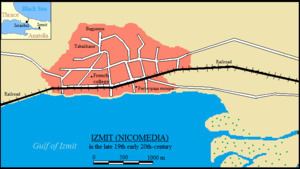Date March 1920 – June 1921 Location İzmit, Turkey | Period June 1920 – June 1921 | |
 | ||
Participants (mainly) Turkish nationalist Army and irregulars, on a minor scale: Greek army, (insubordinate role) Circassian mercenaries Deaths 12,000 by the Turkish Army (+ 2,500 missing)
~ 300 by the Greek Army | ||
The Izmit massacres refer to atrocities committed in the region of Izmit, Turkey, during the Greco-Turkish War (1919-1922). An Allied commission that investigated the incidents, submitted a report, on June 1, 1921, about the events. In general it accepted the Greek claims that Turkish troops massacred more than 12,000 local civilians, while 2,500 were missing and stated that the atrocities committed by the Turks in the Izmit peninsula "have been more considerable and ferocious than those on the part of the Greeks".
Contents
Incidents
Ethnic cleansing policies undertaken by the Ottoman government were launched in various regions of the Ottoman Empire, including Izmit region, as soon as 1915. This included the massive deportation of local Greek and Armenian populations. Later, in 1918, after the Armistice of Mudros a number of attacks of nationalist bands against the local Christian population was reported. This violence increased against the local Greek population, from March 1920 and especially during June–July 1920, when the advance of the Greek army in the region was imminent. These groups were operating as far as Üsküdar, while some of them were organized by the Turkish National Movement.
As a result of this activity, several villages of the region were burnt and their population decimated, especially in the regions south, north and northeast of Adapazarı, as well as south and southeast of Iznik.
The presence of the Greek army in the region from July 1920, limited the activity of the Turkish bands, although in Karamürsel, south of the Gulf of İzmit, some Turkish nationalists groups were still attacking surrounding villages inhabited by Greek populations.
Later, the Greek army in the region, was accused for supporting assaults against some villages east of Beykoz. Accusations included the killing of civilians and the burning of small settlements. Accusations also included violence perpetrated by local Greek civilians that previously suffered from Turkish atrocities
From the spring of 1921, the activity of the Turkish bands increased in the region extending geographically to the south of Izmit, which resulted in the destruction of the Christian villages there.
Evacuation of Izmit
In the early summer of 1921, due to the developments of the ongoing Greco-Turkish War, the retreat of the Greek army was imminent. The Christian population had become panic-stricken fearing a wholesale massacre by the Kemalists, so it was decided that the civilians were to be evacuated. As a result, a total of 22,000 inhabitants who had sought refuge in the city during the Greek occupation in addition to the ca. 10,000 Greek and Armenian inhabitants of the city who wished to be evacuated in order to avoid persecutions by the Turkish national movement, left the area. According to the British High Commission, 33,000 people were evacuated. Of these, approximately 21,000 were Greeks, 9,000 were Armenians, and 3,000 were Turks and Circassians. They were distributed as follows:-
Aftermath
An Allied commission that investigated the incidents in the region accepted the Greek claims that Turkish troops massacred more than 12,000 local civilians, while 2,500 were missing was accepted by the commission as fundamentally true, "not withstanding a certain amount of exaggeration in the figures".
According to British journalist and latter historian, Arnold Toynbee, as a result of the activities of the Greek army and irregulars, up to 300 persons were killed. Toynbee in general omits to notice the conclusion of the Allied commission. Moreover, Winston Churchill, stated that the Greek atrocities were on a minor scale compared to the appalling deportations of Greeks from the Trebizond and Samsun provinces, undertaken by the Turkish nationalists in the same year.
Partial list of affected settlements
The Allied commission concluded that 35 villages in the region were affected due to the activity of Turkish nationalist bands. A partial list of the villages according to Greek reports:
